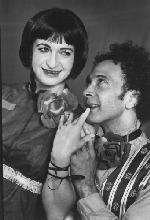SEARCH CurtainUp
REVIEWS
FEATURES
NEWS (Etcetera)
ADDRESS BOOKS
Broadway
Off-Broadway
BOOKS and CDs
OTHER PLACES
Berkshires
London
Los Angeles
Philadelphia
Elsewhere
QUOTES
On TKTS
LETTERS TO EDITOR
FILM
LINKS
MISCELLANEOUS
Free Updates
Masthead
NYC Weather
Crazy Day or The Marriage of Figaro
by Les Gutman
|
Are we ever grateful for luxuries from people who deprive us of necessities? ---Figaro |

R. Groff and R. A. Owens (Photo: Paula Court) |
The Marriage of Figaro is the sort of play that fits Target Margin's approach to theater like a glove. (The company's suitably abstract founding principle: "works of art return us to real truths most powerfully by their divergence from a strict illustration of reality.") It is a byzantine tale that makes Feydeau seem simple, laced with biting satire of "nobility". Under David Herskovits's ever-winking direction, the production seizes the play's ridiculously comic invention as a badge it wears on its sleeve.
One might question how a play the central plot element of which is the abolition and reïnstatement of droit du seigneur (the right of a nobleman to take his manservant's place on the latter's wedding night) can be anything but an artifact. Fear not, as this company refuses to surrender to an intellectual distancing, instead repeatedly reminding itself and its audience that it is participating in a farce. This is a company that has developed its own sensibility and style, which is legitimized by the authority and intelligence with which it collectively executes that which it has set out to do. There will be those for whom Target Margin's brand of theater will never be satisfying, but for me, The Marriage of Figaro weds those elements that show Target Margin at its best.
The added title Crazy Day aptly describes the plot, which dares one to summary in the space available in a review. I'll try. Figaro (Robert Alexander Owens), barber and valet to a Count (Paul Vincent Black) in Seville in the 18th Century, is to marry Suzanne (Rinne Groff), a maid to the Countess (Kwana Martinez). But the Count lusts after Suzanne; a doctor named Bartholo (Yuri Skujins) wants Figaro to marry his maid, Marceline (Joyce Lee), as repayment for a debt and the Countess just wants some attention from her husband. Another servant, Cherubin (Alvaro Heinig), lusts after the Countess, as well as another servant, Fanchette (Christy Meyer) and seemingly every other female able to take in oxygen. There is a lot of eavesdropping, gossiping, dressing up in disguises (most prominently but far from exclusively, by Suzanne as the Countess and vice versa, as a trick), hiding in closets and jumping out of windows. There's also the startling (to all) discovery that Figaro is the birth child of Marceline and Bartolo. By play's end, most everything gets sorted out, the Count is contrite and the craziness subsides.
The performances, production elements and script ("translated," we are informed, by "the company") are quite clearly of a piece. The actors ooze with the prevailing tone, none more so than Mr. Owens. Also especially noteworthy are the always effective Ms. Groff, and the newcomer (to me at least) Kwana Martinez.
Emily Phillip's set design augments the columns that frame the Ohio Theatre stage with matching columns that move. They provide useful surfaces to hide behind when upright, but when one is turned on its side in the famous "closet" scene, the translation coaxes along our imagination by calling it the "thing". At other times when our imagination might need a bit of help, cast members appear bearing signs telling us something is a window or a gazebo. Props are stored in foiled cages lining both sides of the stage until required, and there is also a striking maze of paths fashioned out of a different sort of bluish foil with disk-shaped patterns that conspires with interesting lighting effects to create a rather elegant final scene or two.
The formality of revolutionary France is intertwined with the self-consciously contemporary, the subversiveness of Beaumarchais's social commentary supplanted by a sort of theatrical anarchy. "Stop listening to my asides!" the Count commands.
The season will continue with a laboratory presentation, in repertory, based on Wagner's Ring Cycle, and conclude with an original opera, The Sandman, based on a story by E. T. A. Hoffmann.
|
Crazy Day or The Marriage of Figaro
by Pierre Augustin Caron de Beaumarchais, translated by the company Directed by David Herskovits with Rinne Groff, Robert Alexander Owens, Paul Vincent Black, Christy Meyer, Yuri Skujins, Joyce Lee, Kwana Martinez and Alvaro Heinig Set Design: Emily T. Phillips Costume Design: Miranda Hoffman Lighting Design: Josh Epstein Sound Design: Michael Kraskin and David Herskovits Running Time: 1 hours, 30 minutes including no intermission Ohio Theatre, 66 Wooster Street (Spring/Broome Streets) Telephone (212) 358-3657 Opens October 17, 2001, closes November 17, 2001 TUES - SAT @8, SUN @3 and 7; $15 Reviewed by Les Gutman based on 10/18/01 performance |

6,500 Comparative Phrases including 800 Shakespearean Metaphors by CurtainUp's editor.
Click image to buy.
Go here for details and larger image.



